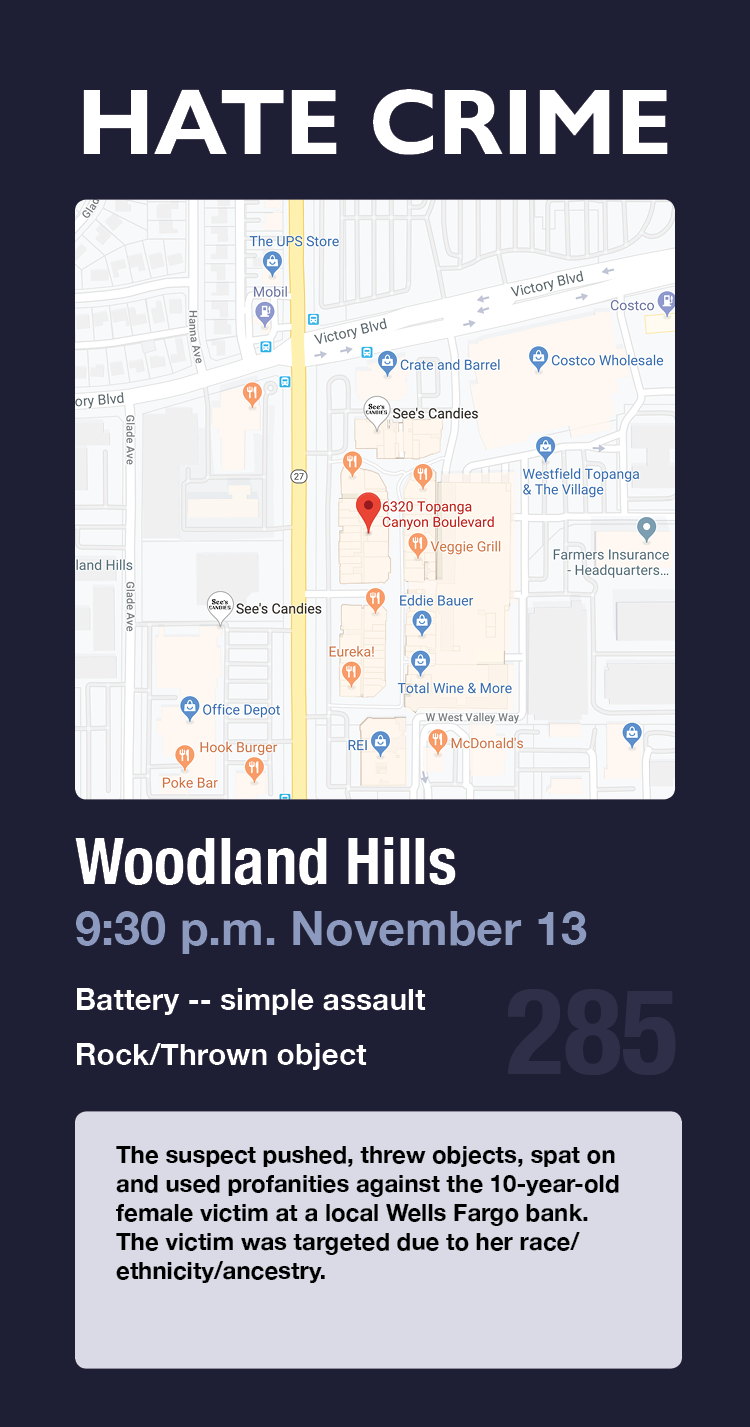What I learned from a year of covering hate crimes
There were 320* hate crimes committed in the City of Los Angeles last year. I covered every one of them.
This was part of an experiment we conducted at Crosstown: If we automatically scanned police records for every hate crime, would a pattern emerge? Would this tell us something about our city we hadn’t known? Our goal, as outlined by Editor-in-Chief Gabriel Kahn, was not to sensationalize each instance, but to measure the cadence of intolerance.
Crosstown is an experiment in how data can be harnessed to reinvigorate local journalism. So we leaned on our in-house data scientists to build a Slackbot that would ping us every time the Los Angeles Police Department registered a new hate crime.
Though I wrote up a synopsis of each hate crime, there is still so much I do not know. We are limited by the data LAPD provides to the public. We do our best to decipher their numeric codes into a narrative. For example, a police record that contains “0903” is a hate crime. One that also has “0906” means that it is gang-related. If it also has “0421,” then the underlying crime committed was a death threat.
Here is what one of our hate crime “cards” looks like:

Sometimes, these codes expose chilling details, as on Oct. 16, when multiple suspects overwhelmed a 60-year-old transient black male in Echo Park, threatened him, bit him and hurled racial slurs. Or in Rancho Park, when, on Sept. 13, a suspect threatened four black students with a knife while shouting bigoted profanities.
The data can also bring quantifiable precision to a creeping climate of racism and bigotry. The 320 reported hate crimes of 2019 represent an 8.5% increase from a year earlier. Reports of hate crimes have been rising steadily since 2014, when there were 170. Out of 14 anti-transgender hate crimes last year, 11 of them targeted transgender women of color.
But more often, we are left with frustrating gaps about these incidents. The LAPD’s data can be spotty. Sometimes the details are so spare that it isn’t at all clear why the incident was classified as a hate crime in the first place. Occasionally, reports that were initially classified as hate crimes are reclassified as run-of-the-mill assaults or robberies. And vice versa. We never learn the motivation of the suspect or the fate of the victim.
I have not seen the faces of the victims, nor have I talked to them, at least in person. The data provides no details about their identity. Our requests for full police transcripts of incidents usually run into a brick wall; the department refuses to release them because, as is typical of hate crimes, they remain under investigation.
And, of course, we only know of the hate crimes that are reported to the police. Many others never make it into the public record.
As of this moment, the LAPD’s crime code manual does not have codes that identify the suspects’ potential beliefs or their affiliated hate groups – like the Atomwaffen Division, the Proud Boys and the Rise Above Movement, all violent white-supremacist groups active in Southern California. Hate crimes involving white supremacist groups encompassed 16% of all hate crimes that were recorded in Los Angeles County in 2018, according to the Los Angeles County Commission on Human Relations. Gang-related hate crimes made up 9%.
Still, LAPD is among the best in the nation when it comes to keeping track of this data. “We should recognize not many cities have a hate crime-specific division in their police departments,” says Prof. Brian Levin, the director of the Center for the Study of Hate and Extremism at the California State University, San Bernardino.
Last year, LAPD’s chief hate-crimes coordinator, Det. Orlando Martinez, instituted a new policy that uses 35 different codes to identify the bias motivations of the suspect and six different codes to identify if the victim was targeted for sex, gender, sexual orientation, religion and race. For example, “1536” refers to anti-gay bias, which was recorded 48 times last year.
Obtaining more details on hate crimes can also walk a fine line between thorough reporting and exploiting personal information. Marshall Wong of the Los Angeles County Commission on Human Relations warned me that by disclosing the specifics, I could be neglecting victims’ wishes to move on from traumatic experiences or reveal sexual orientation without their consent.
As important as it is to keep an impartial barometer on the development of hate in the city, I often felt like I am merely tracing the expanding aftermath of a growing social illness.
At the close of the year, there are more things I do not know about these crimes than things I do know. Crosstown has always been about reimagining local journalism to better fit the needs of its community and knowing what we do well and not well is where it all begins. In 2020, we will be rolling out an entirely new approach to reporting hate crimes, one which can give our readers a more refined and up-to-date picture about what is happening in our city. Stay tuned.
Read our hate crime alerts here.
* Because the LAPD occasionally updates its crime data as its investigations progress, this year-end total may change.






